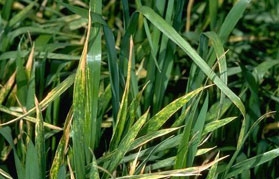First draft of genome of wheat stripe rust published in Public Library of Science
UC Davis Department of Plant Sciences researchers are the leading authors of an article published in the journal Public Library of Science which presents a first draft of the genome of wheat stripe rust (Puccinia striiformis), one of the most devastating pathogens of wheat.
The stripe rust disease of wheat caused by the highly specialized fungal pathogen Puccinia striiformis f. sp. tritici has been responsible for recurrent episodes of large yield losses and economic hardship among grain-based agricultural societies for centuries. Current epidemics of new aggressive races of Puccinia striiformis that appear after the year 2000 pose significant threats to food security worldwide and, in particular, in developing countries in Africa and central Asia. In spite of its economic importance, the Puccinia striiformis genomic sequence is not currently available.
In order to get access to the genes of this pathogen, a team of researchers – including Professor Jorge Dubcovsky (also a Howard Hughes Medical Institute researcher) and Professor Richard Michelmore, director of the UC Davis Genome Center, Project Scientist Dario Cantu and Manjula Govindarajulu, a postdoctoral researcher in Michelmore’s lab - used cutting-edge technology to rapidly sequence a large portion of the genome of one of the Puccinia striiformis more virulent and aggressive races. They assembled long stretches of the Puccinia striiformis genome and established a preliminary automatic annotation of its genes, with a special focus on those likely to be involved in pathogenicity.
This information is available in the open-access article published by the Public Library of Science and made publically available through the National Center of Biotechnology information and a dedicated web page.
“This shotgun sequence assembly does not substitute for the need of a complete and annotated Puccinia striiformis genome, but it provides immediate access to a large proportion, more than about 88 percent, of the genes from this pathogen,” said Cantu. “This public information has the potential to accelerate a new wave of studies to determine the mechanisms used by this pathogen to infect wheat, and hopefully to reduce current yield loses caused by this pathogen.”
These researchers, in collaboration with others at the John Innes Institute in the UK, are currently sequencing new and old races of Puccinia striiformis to investigate their differences in virulence and aggressiveness.
This project was supported in part by funds provided through a grant from the Bill & Melinda Gates Foundation, and the National Research Initiative Competitive Grants from the USDA National Institute of Food and Agriculture.

